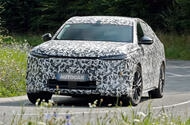What’s Changing with the New DS 7 and Why Should You Care?
If you’ve been following the evolution of DS Automobiles, you know the brand has had its ups and downs—especially in the wake of the pandemic. European sales dropped by 22% last year, and the company’s parent, Stellantis, even considered selling the marque. But now, DS is making a bold move to turn things around with the second-generation DS 7, an SUV that’s not just getting a facelift but a complete reinvention. And yes, it’s going all-in on electric.
Why Is DS Ditching Combustion Engines for the New 7?
Let’s be honest: the writing’s been on the wall for combustion engines in Europe for a while. With increasingly strict emissions regulations and a growing appetite for EVs, DS’s decision to launch the new 7 exclusively as an electric vehicle isn’t just trendy—it’s strategic. The new DS 7 will ride on the STLA Medium platform, a cutting-edge architecture from Stellantis designed specifically for electric powertrains.
This move positions the DS 7 right alongside heavy hitters like the BMW iX3 and Mercedes-Benz GLC, both of which are setting the pace for premium electric SUVs. For DS, it’s a chance to compete where the action is hottest, rather than playing catch-up in a shrinking combustion market.
What’s New Under the Hood (and Floor) of the DS 7?
Here’s where things get interesting. The STLA Medium platform isn’t just a buzzword—it’s a game-changer. The new DS 7 will offer two battery sizes and three powertrain options:
– A 73.7kWh battery paired with a 256bhp front-wheel-drive setup, delivering up to 355 miles of range.
– A larger 97.2kWh battery with 276bhp, stretching the range to an impressive 466 miles.
– A top-tier twin-motor, all-wheel-drive version boasting 345bhp and a 407-mile range.
These numbers aren’t just competitive—they’re leading the pack. For context, the latest data from the European Automobile Manufacturers Association shows that average EV ranges in 2023 hovered around 250-300 miles, so DS is clearly aiming to outdo the status quo.
Could There Be a Gasoline Version Down the Road?
While the launch focus is squarely on electric, DS isn’t slamming the door on combustion entirely. The STLA Medium platform can accommodate an internal combustion engine, and DS’s own product boss, Cyprien Laurentie, has hinted that it’s “a possibility” for the future. For now, though, the plan is to go electric-only, at least at launch, following the precedent set by the new DS Nº8 flagship.
How Is the Design Evolving? Will It Stand Out?
Design has always been DS’s calling card, and the new 7 is no exception. Even under heavy camouflage, test mules show off a flatter front fascia, a more pronounced nose, and a wraparound light bar—styling cues borrowed from the striking DS Nº8. The new model is also larger than its predecessor, giving it more road presence and, presumably, more interior space.
This isn’t just about looking good in a showroom. In the premium SUV segment, first impressions matter, and DS is betting that a bold, modern design language will help it stand out in a crowded field.
Why Is This Launch So Critical for DS?
Let’s not sugarcoat it: DS needs a win. The current DS 7 and DS 9 managed just over 500 combined sales in the UK this year before being pulled, with the 7 accounting for more than 90% of those. That’s a drop in the ocean compared to rivals. But DS’s new boss, Xavier Peugeot, is clear that it’s not just about chasing volume. In his words, “The premium market is a quarter of the sales volumes, but it makes up 40% of the profits.” In other words, it’s better to sell fewer cars at higher margins than to chase mass-market numbers.
The new DS 7 is also part of a broader strategy to refresh the entire DS lineup, alongside the Nº8 and the upcoming Nº4. After several years without major launches, this is DS’s chance to reassert itself as a serious player in the premium segment.
How Does the DS 7 Stack Up Against the Competition?
It’s a tough crowd out there. The BMW iX3 and Mercedes-Benz GLC are both formidable, with strong brand recognition and loyal followings. But DS is carving out a niche by focusing on design, technology, and electric performance. With longer range options and a fresh look, the new 7 could appeal to buyers who want something a little different from the usual German suspects.
Real-world example: In Norway, one of Europe’s most advanced EV markets, buyers are increasingly looking beyond established brands for something unique. DS’s French flair and attention to detail could resonate with those who want to stand out without sacrificing performance or range.
What Should You Watch for Next?
The second-generation DS 7 is expected to be revealed next year, and anticipation is building. If DS can deliver on its promises—especially on range, design, and tech—it could mark a turning point for the brand. For buyers, it means another compelling option in the fast-growing electric SUV market.
The bottom line? DS isn’t just updating a model—it’s betting its future on the new 7. Whether you’re a longtime fan or just EV-curious, this is one launch worth keeping an eye on.

